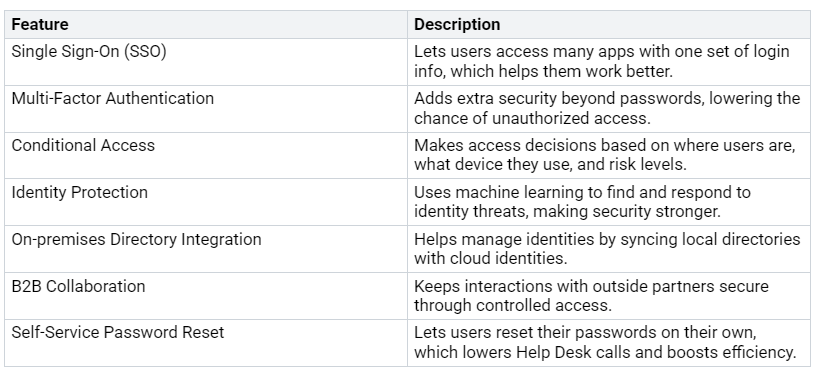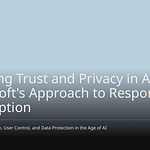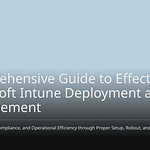The move to passwordless solutions is a significant shift in the future of identity management. By 2023, 92% of organizations aim to transition to these methods. Passwordless authentication eliminates the need for passwords, allowing users to log in using biometrics or hardware tokens. This approach enhances security and simplifies the user experience. As organizations navigate this transformation, Microsoft Entra stands out as a leader. It offers tools that facilitate this transition and safeguard your organization’s identity in today’s complex digital landscape.
Key Takeaways
Passwordless solutions make security better by removing passwords. This cuts down risks from theft and phishing attacks.
Users have an easier login process. Biometrics let them log in 66% faster than using regular passwords.
Organizations can save a lot of money. They do this by having fewer IT help desk calls about password resets. This helps overall productivity.
Microsoft Entra gives important tools for using passwordless solutions. This improves both security and user access.
Using passwordless methods can have some problems. But good training and communication can help make the change easier.
Passwordless Solutions Overview
Definition and Functionality
Passwordless solutions are a new way to log in. Instead of using passwords, these methods check who you are with biometrics, hardware tokens, or special identifiers. This change makes security better by lowering risks from password theft and phishing scams. You won’t have to remember hard passwords anymore, which makes logging in easier.
Passwordless authentication works by checking your identity right away. Here are some important features of this technology:
It removes the need for passwords, making phishing scams useless since there’s no password to steal.
It improves security by solving problems with stolen credentials.
Ongoing checks make sure your identity stays safe during your session.
Key Technologies
Many technologies make passwordless authentication possible. Knowing these can help you pick the best solution for your organization. Here’s a list of the most common types:
One-Time Password (OTP) / One-Time Code (OTC)
TOTP (Time-Based One-Time Password)
HMAC-based One-Time Password (HOTP)
Magic Links
Unique Authenticators
Social Logins
Biometric Authentication
Smart Card
Persistent Cookie
Also, technologies like biometrics and hardware tokens are very important here. For example, biometric authentication uses unique traits, like fingerprints or facial recognition, to confirm identity. Hardware tokens, such as USB security keys, keep cryptographic keys for safe access.
As more organizations use zero trust frameworks, passwordless solutions become essential. They help with ongoing authentication and lower the chance of unauthorized access, boosting your security.
Benefits of Passwordless Solutions
Enhanced Security
Passwordless solutions make security much better. They fix the problems that come with regular password systems. When you get rid of passwords, you lower the chances of password hacks. Passwordless methods, like using your fingerprint or special tokens, are harder to fake or steal. Here are some important points:
Passwordless methods mean you don’t have to remember passwords. This lowers the chances of security problems.
Stronger methods, like biometrics, give better security.
Without passwords to steal, you greatly lower the risk of phishing attacks.
With these steps, organizations that use passwordless solutions usually have fewer data hacks and phishing problems than those that still use regular passwords.
Improved User Experience
Switching to passwordless solutions makes the user experience much better. You won’t need to remember hard passwords or deal with annoying resets. Instead, you can log in fast and easy. Think about these benefits:
Users log in 66% faster with biometrics than typing passwords.
More than 90% of users feel less frustrated when logging into apps.
Passwordless solutions remove the need for tricky password resets, which often cause people to leave their accounts.
This easier process not only makes users happier but also helps them work better. Organizations save a lot of time on user logins, letting employees focus on their main jobs.
Operational Efficiency
Using passwordless solutions brings big operational benefits. Organizations can save important resources by getting rid of password management tasks. Here are some key facts:
Up to 50% of IT help desk costs come from password resets, costing about $70 each time.
By cutting down on password reset calls, organizations can save hundreds of thousands of dollars each year.
Switching to passwordless methods can boost productivity by up to 42%.
These benefits help create a more secure environment. Organizations that use passwordless solutions often find they can use IT resources for more important projects instead of wasting time on password issues.
Challenges in Adoption
Switching to passwordless solutions can be hard for organizations. Knowing these challenges can help you make the change easier.
Technical Barriers
Many technical problems can slow down your move to passwordless authentication. Here are some common issues:
Legacy system compatibility: Your organization might use old systems that don’t work with passwordless methods. This can delay your transition.
User adoption and training: Users who aren’t tech-savvy may find passwordless methods hard to understand. You will need to give thorough training so everyone knows the new processes.
Backup authentication methods: Most systems still need a backup method, usually a regular password. This can create weaker security.
Biometric data privacy concerns: Using biometric data brings up important privacy and legal issues that you must handle.
Hardware requirements: Some passwordless solutions need special hardware, which can be expensive for larger organizations.
Interoperability challenges: Making sure access works smoothly across different systems can be tough for your IT team.
Regulatory considerations: You might have rules that affect your choice of authentication methods.
User Resistance
User resistance can also be a big challenge. Many employees may worry about current systems or think their security is good enough. Changing to new technologies can feel complicated and scary. To help with this resistance, you should teach users about the benefits of passwordless solutions. Clear communication and support can help ease their worries and encourage them to adopt the new methods.
Privacy and Compliance Issues
Privacy rules, like GDPR, can impact how you use passwordless authentication solutions. While passwordless methods improve the security of personal data, they also need you to use strong authentication methods. Good cryptographic techniques must meet data security rules under GDPR Articles 5 and 32. Making sure you follow these rules is important for protecting your organization and its users.
By facing these challenges directly, you can make the switch to passwordless solutions smoother. This will improve the future of identity management in your organization.
Microsoft Entra: The Future of Identity Management
Microsoft Entra is a strong tool for managing identities today. It has many features that improve security and make user access easier. Here are some main features that make Entra different from other identity management tools:
AI-Driven Security
Microsoft Entra uses artificial intelligence to improve security in identity management. This helps you stay ahead of possible threats. Here are some key ways Entra uses AI:
Security Copilot helps identity teams stay ahead of dangers.
Natural language prompts help check risky users and find login problems.
Entra’s AI features include:
With these features, Microsoft Entra ID uses machine learning to spot and reduce security risks. It gives a full view of risk events and suggests actions to fix them. Smart security measures keep checking user behavior to find problems, making sure your organization stays safe.
Governance and Compliance
Governance and compliance are very important for organizations using passwordless authentication. Microsoft Entra meets these needs well. It lets you use passwordless methods while boosting security. Here are some key ways Entra helps with governance and compliance:
Secure access methods make sure only authorized users can see sensitive information.
Conditional access policies enforce security rules based on user context.
User management features help keep control over user identities and access rights.
By addressing these governance and compliance needs, Microsoft Entra stands out as a leader in the future of identity management. It not only makes access easier but also strengthens your organization’s security.
Real-World Applications
Passwordless solutions are changing how organizations work in many areas. You can see their effects through real examples that make security better and help users.
Case Studies
Many organizations have used passwordless solutions successfully. Here are some important examples:
Intuit’s use of a passwordless solution led to much less customer frustration and lower costs. Users had a high success rate of 95% to 97% for logging in, which is much better than the 80% success rate of regular multi-factor authentication. Plus, the sign-in process was 70% faster than non-FIDO sign-ins.
Industry Adoption Trends
More industries are quickly adopting passwordless solutions. Here are some important trends:
The Banking, Financial Services, and Insurance (BFSI) sector is leading in using passwordless authentication.
Government agencies are using these solutions more to protect sensitive data.
The healthcare sector is expected to grow fast because of rules and the need to secure patient information.
In 2024, the government had the biggest market share due to the need for strong security with classified information. BFSI held the largest share of 27.30% in the global passwordless authentication market. The healthcare area is expected to grow at a rate of 18.70% during the forecast period.
These trends show how important passwordless solutions are for the future of identity management. As organizations keep using these technologies, you can expect better security and user experiences in all areas.
Using passwordless solutions is very important for making your organization’s security better. These methods not only make it easier for users but also lower the risks that come with regular passwords. For example, passwordless authentication means users do not have to remember hard passwords, which makes their online experiences smoother.
Microsoft Entra is key in this change. It provides different passwordless options, like Windows Hello and FIDO2 security keys, which boost security and help users. By seeing identity as a key part of your security plan, you can protect your organization better in the changing world of digital identity management.
Embrace the future of identity with passwordless solutions and Microsoft Entra to secure your digital assets effectively.
FAQ
What are passwordless solutions?
Passwordless solutions let you log in without passwords. They use things like biometrics or hardware tokens to check who you are. This makes security better and access easier.
How does Microsoft Entra support passwordless authentication?
Microsoft Entra offers different passwordless options, like Windows Hello and FIDO2 security keys. These tools make security stronger and help users access apps more easily.
Are passwordless solutions secure?
Yes, passwordless solutions greatly improve security. They lower the chances of password theft and phishing attacks. This makes it much harder for unauthorized people to get in.
What challenges might I face when adopting passwordless solutions?
You might face technical issues, user pushback, and privacy rules. Dealing with these problems through training and clear communication can help make the change easier.
How can I implement passwordless solutions in my organization?
Begin by checking your current systems and finding passwordless technologies that work with them. Train users and set clear rules to help the transition go smoothly.













